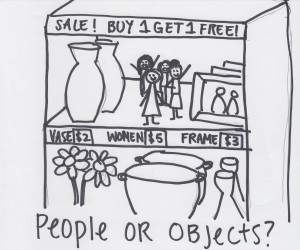 The annoying thing about writing about Robin Thicke is that it gives him exactly what he wants: more publicity. When Diane Martel, director of the “Blurred Lines” video (as well as the video for Miley Cyrus’s “We Can’t Stop”) was asked where she came up with the concept for “Blurred Lines” she told Eric Ducker of Grantland, “I want to make videos that sell records. This is my main focus right now … to make videos that move units.”
The annoying thing about writing about Robin Thicke is that it gives him exactly what he wants: more publicity. When Diane Martel, director of the “Blurred Lines” video (as well as the video for Miley Cyrus’s “We Can’t Stop”) was asked where she came up with the concept for “Blurred Lines” she told Eric Ducker of Grantland, “I want to make videos that sell records. This is my main focus right now … to make videos that move units.”
It’s hard to imagine that Thicke and his production team were completely oblivious to the type of backlash the video would create. Thicke himself in an interview for GQ magazine said, “We tried to do everything that was taboo. Bestiality, drug injections, and everything that is completely derogatory towards women.”
It’s pretty obvious that the point of the video was to generate controversy—because controversy gets people talking and buying songs. Thicke and his team are almost certainly relishing the massive amount of attention they’re getting from feminist bloggers, the Huffpost staff, and talk show hosts alike.
The fact is, although the video is one big money-making joke for Thicke, it still conveys a dangerous message to the millions watching it.
If you haven’t seen the uncensored video, I’ll summarize it for you. Three topless women wearing nude colored thongs dance around the fully clothed Thicke and Pharrell Williams. They do not sing or speak throughout the video, save a “Meow” spoken by the main model, Emily Ratajkowski. Apparently the video is “actually celebrating women and their bodies,” according to Ratajkowski in an interview with GQ Magazine, a conclusion we are meant to draw from, among other things, the act of a toy car being rolled down her backside while she is on all fours.
The problem with this video, and it might seem like a drastic conclusion to come to, is that it dehumanizes women, making them into props we are meant to ogle. You might dismiss this with a laugh, citing the argument that the video is “just for fun.” However, I think the video has deeper implications.
By reducing the women to visual spectacles, parading around their naked bodies for the enjoyment of males, the video simply reinforces the idea that women are more objects and less so actual people. It’s hard to argue that a video of naked women dancing around awkwardly with fully clothed, predatory- feeling men can do otherwise.
For Marten however, the video is not sexist because it “forces the men to feel playful and not at all like predators. I directed the girls to look into the camera, this is very intentional and they do it most of the time; they are in the power position,” or so she told Ducker.
Ratajkowski also mentioned the fact that the girls look into the camera as a reason why the video was not sexist. I’ll let you be the judge of how “powerful” said eye contact is, but it didn’t seem too empowering to me when it was accompanied by ferocious lip licking and followed by adoring gazes at Thicke.
While Marten, Ratajkowksi and maybe even Thicke might argue that the video has deeper meaning, and even that it is somehow empowering for women, I have a hard time believing that that is the conclusion most viewers will draw from the video. Even if the video was well intentioned (which I really doubt) the main message it conveys is that hey, it’s completely OK to objectify women!
And let’s not forget the lyrics and general premise of the song! Besides Thicke’s constant refrain of “I know you want it,” let’s remember that the video is based off the idea that Thicke wants to “liberate” a “good girl” by having sex with her.
